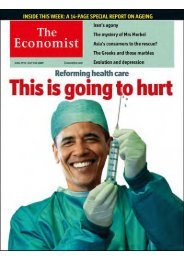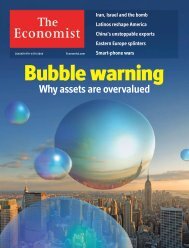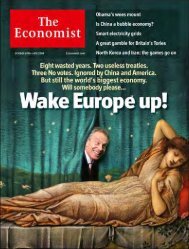Untitled - the ultimate blog
Untitled - the ultimate blog
Untitled - the ultimate blog
Create successful ePaper yourself
Turn your PDF publications into a flip-book with our unique Google optimized e-Paper software.
Assessing quantitative easing<br />
Muzzled<br />
Aug 13th 2009 | WASHINGTON, DC<br />
From The Economist print edition<br />
Politics stops <strong>the</strong> Fed from expanding an asset-purchase scheme<br />
BACK IN 2002, before he became chairman of <strong>the</strong> Federal Reserve, Ben Bernanke claimed that if short-term interest<br />
rates fell to zero, a central bank still had <strong>the</strong> <strong>ultimate</strong> weapon: printing money by purchasing government bonds.<br />
Having now actually tried quantitative easing himself, Mr Bernanke is discovering its limits.<br />
In March <strong>the</strong> Fed announced plans to purchase $300 billion of Treasury debt by September with newly printed money<br />
(to be more precise, electronic money in <strong>the</strong> form of bank reserves) and to more than double planned purchases of<br />
mortgage-related debt to $1.45 trillion. The $300 billion in Treasury purchases, in particular, were widely assumed to<br />
be <strong>the</strong> start of a much more substantive plan. Yet <strong>the</strong> Fed’s latest policy meeting wrapped up on August 12th without<br />
any plans to expand ei<strong>the</strong>r scheme, although it did move <strong>the</strong> completion date for Treasury purchases back to <strong>the</strong> end<br />
of October and kept <strong>the</strong> option of boosting purchases later. It left its short-term interest-rate target at zero to<br />
0.25%. Such inaction contrasts with <strong>the</strong> Bank of England’s decision on August 6th to expand its programme of asset<br />
purchases, mainly of government bonds, from £125 billion ($206 billion) to £175 billion.<br />
Comparisons are inexact. The Fed has been intervening more aggressively than <strong>the</strong> bank in o<strong>the</strong>r ways. The<br />
programmes also have different rationales. The Fed emphasises <strong>the</strong> ability of bond purchases to lower yields and<br />
improve liquidity in private debt markets. The Bank of England says its programme aims to boost spending by<br />
putting more money into <strong>the</strong> economy.<br />
Analysing <strong>the</strong> programmes’ precise impacts is also tricky. Government-bond yields in both Britain and America<br />
initially fell sharply on <strong>the</strong> announcement of <strong>the</strong> asset-purchase programmes, which are substantial relative to GDP<br />
(see chart). Yields have since retraced that drop in Britain and bounced higher than before in America. But lots of<br />
factors are at play. Expected inflation (as implied by <strong>the</strong> gap between conventional and inflation-indexed bond yields)<br />
has risen. The fear of global meltdown that drove investors to <strong>the</strong> safety of governments bonds has ebbed.<br />
Never<strong>the</strong>less, an IMF study estimates that Britain’s longer-term yields are 40-100 basis points lower than <strong>the</strong>y would<br />
have been without <strong>the</strong> bank’s purchases.<br />
The impact on private yields is also probably positive. Macroeconomic<br />
Advisers, a consultancy, estimates that American mortgage rates are a<br />
percentage point lower relative to Treasuries as a result of <strong>the</strong> Fed’s asset<br />
purchases. The Bank of England takes some credit for a narrowing in<br />
corporate-bond spreads. The European Central Bank says <strong>the</strong> announcement<br />
of plans to buy €60 billion ($85 billion) of covered bonds has helped revive<br />
new issuance and bring down spreads.<br />
If <strong>the</strong> programmes are doing some good, why is <strong>the</strong> Fed not expanding<br />
<strong>the</strong>m? The outlook has improved, for one thing: America’s economy is<br />
levelling out, it noted on August 12th. But <strong>the</strong> main reason is political, not<br />
economic. The Fed’s Treasury-purchase plan prompted charges that it was<br />
inviting hyperinflation and had subordinated itself to <strong>the</strong> government’s deficit<br />
needs. Alan Greenspan, a former Fed chairman, says inflation will exceed<br />
10% if <strong>the</strong> Fed fails to shrink its balance-sheet and raise rates, and 3% for a<br />
time even if it does.<br />
Needless to say, that is not <strong>the</strong> Fed’s view: it still foresees rising unemployment and falling inflation. But many<br />
officials have concluded that, for now, <strong>the</strong> benefits of buying more Treasuries do not outweigh <strong>the</strong> costs of a<br />
damaging rise in inflation expectations and a perceived loss of independence. Even <strong>the</strong> <strong>ultimate</strong> weapon is useless if<br />
you are too nervous to use it.<br />
Copyright © 2009 The Economist Newspaper and The Economist Group. All rights reserved.<br />
-109-








![[ccebbook.cn]The Economist August 1st 2009 - the ultimate blog](https://img.yumpu.com/28183607/1/190x252/ccebbookcnthe-economist-august-1st-2009-the-ultimate-blog.jpg?quality=85)



![[ccebook.cn]The World in 2010](https://img.yumpu.com/12057568/1/190x249/ccebookcnthe-world-in-2010.jpg?quality=85)
![[ccemagz.com]The Economist October 24th 2009 - the ultimate blog](https://img.yumpu.com/5191885/1/190x252/ccemagzcomthe-economist-october-24th-2009-the-ultimate-blog.jpg?quality=85)